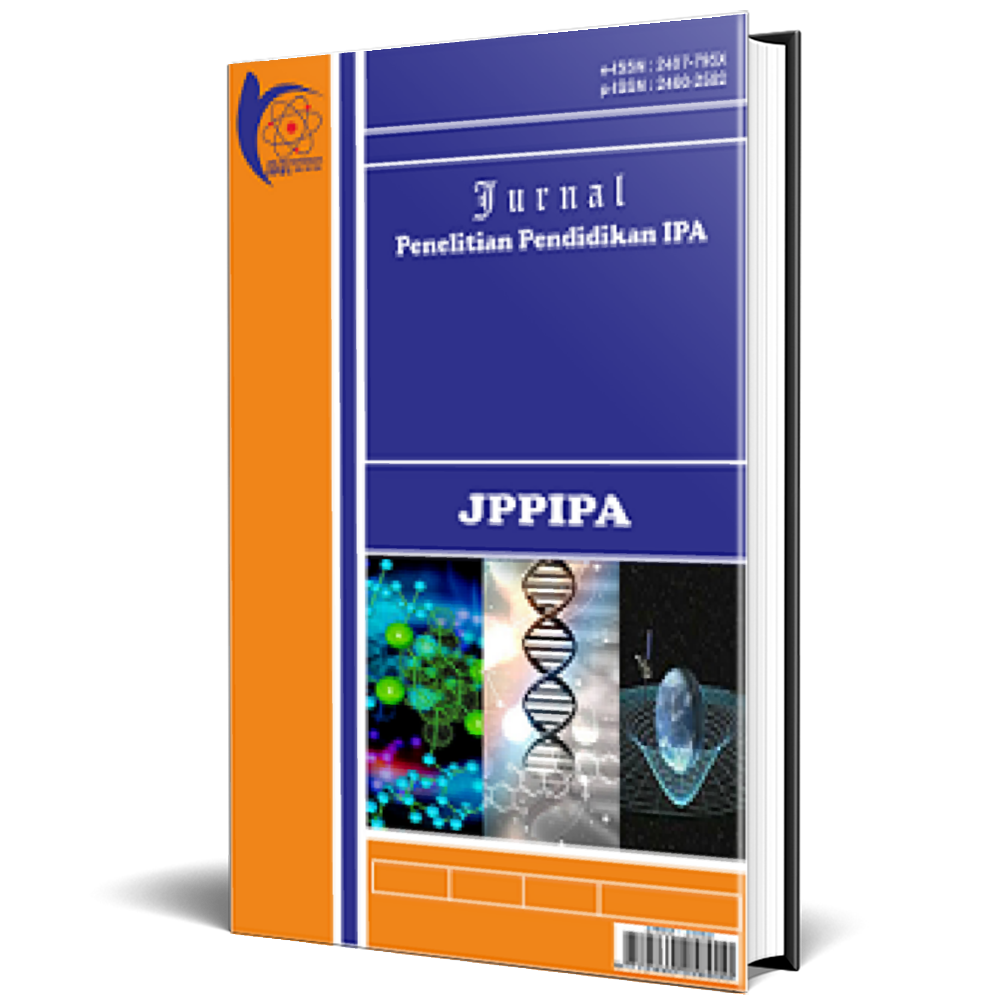Development Of Test Instruments to Improve Students' Multirepresentational Ability
DOI:
10.29303/jppipa.v9i11.5286Published:
2023-11-25Issue:
Vol. 9 No. 11 (2023): NovemberKeywords:
linear motion material, multi-representation ability, two-tier multiple choice test instrumentResearch Articles
Downloads
How to Cite
Downloads
Metrics
Abstract
The aim of this research is to determine the feasibility of a physics test instrument to measure high school students' multiple representation abilities in rectilinear motion material and to determine the characteristics of respondents' multirepresentation abilities in rectilinear motion material. The development of this instrument was carried out using a modified development method of the Wilson, Oriondo, and Antonio. Students' multiple representation abilities were analyzed with the help of Quest which was then analyzed further using descriptive statistics. The results of this research are in the form of a test instrument to measure high school students' multi-representation abilities in rectilinear motion material consisting of 20 two-tier multiple choice questions. The items in the questions are valid, fit the PCM 1 PL model, have very good reliability with a score of 0.84, and have a good level of difficulty. The results of item analysis and analysis of students' abilities show that the instrument developed is effective in measuring high school students' multi-representational abilities in rectilinear motion material.
References
Arikunto, S. (2012). Dasar- Dasar Evaluasi Pendidikan. Bumi Aksara.
Bollen, L., Van Kampen, P., Baily, C., Kelly, M., & De Cock, M. (2017). Student difficulties regarding symbolic and graphical representations of vector fields. Physical Review Physics Education Research, 13(2), 020109. https://doi.org/10.1103/PhysRevPhysEducRes.13.020109
Ceuppens, S., Deprez, J., Dehaene, W., & De Cock, M. (2018). Design and validation of a test for representational fluency of 9th grade students in physics and mathematics: The case of linear functions. Physical Review Physics Education Research, 14(2), 020105. https://doi.org/10.1103/PhysRevPhysEducRes.14.020105
Fatmaryanti, S. D., & Sarwanto, S. (2015). Profil Kemampuan Representasi Mahasiswa Pendidikan Fisika Universitas Muhammadiyah Purworejo. Jurnal Pendidikan Fisika dan Keilmuan (JPFK), 1(1), 20. https://doi.org/10.25273/jpfk.v1i1.8
Furqon, M. & Muslim. (2019). Investigating the ability of multiple representations and scientific consistency of high school students on newton’s laws. Journal of Physics: Conference Series, 1280(5), 052041. https://doi.org/10.1088/1742-6596/1280/5/052041
Hambleton, R. K., Swaminathan, H., & Rogers, H. J. (1991). Fundamental of item response theory. Sage Publication.
Hill, M., Sharma, M. D., & Johnston, H. (2015). How online learning modules can improve the representational fluency and conceptual understanding of university physics students. European Journal of Physics, 36(4), 045019. https://doi.org/10.1088/0143-0807/36/4/045019
Istiyono, E., Mardapi, D., & Suparno, S. (2014). Pengembangan Tes Kemampuan Berpikir Tingkat Tinggi Fisika (Pysthots) Peserta Didik SMA. Jurnal Penelitian dan Evaluasi Pendidikan, 18(1), 1–12. https://doi.org/10.21831/pep.v18i1.2120
Kaplan, R. M, S., D. P. (2018). Psychological Testing: Principles, Applications, and Issues. Cengage Learning.
Klein, P., Müller, A., & Kuhn, J. (2017). Assessment of representational competence in kinematics. Physical Review Physics Education Research, 13(1), 010132. https://doi.org/10.1103/PhysRevPhysEducRes.13.010132
Kubsch, M., & Hamerski, P. C. (2022). Dynamic Energy Transfer Models. The Physics Teacher, 60(7), 583–585. https://doi.org/10.1119/5.0037727
Kusumawati, I., Kahar, M. S., Khoiri, A., & Mursidi, A. (2019). Differences analysis understanding the concept of students between the three islands (Java, Kalimantan, Papua) through multiple representations approaches to the material of Time Dilation. Journal of Physics: Conference Series, 1153, 012145. https://doi.org/10.1088/1742-6596/1153/1/012145
Lichtenberger, A., Wagner, C., Hofer, S. I., Stern, E., & Vaterlaus, A. (2017). Validation and structural analysis of the kinematics concept test. Physical Review Physics Education Research, 13(1), 010115. https://doi.org/10.1103/PhysRevPhysEducRes.13.010115
Majidi, S. (2012). Structural Patterns and Representation Forms of University Physics Teachers: Biot-Savart Law And Am-Père’s Law. Journal of Baltic Science Education, 11(4), 318–332. https://doi.org/10.33225/jbse/12.11.318
Nichols, K., Hanan, J., & Ranasinghe, M. (2013). Transforming the Social Practices of Learning with Representations: A Study of Disciplinary Discourse. Research in Science Education, 43(1), 179–208. https://doi.org/10.1007/s11165-011-9263-0
Nichols, K., Ranasinghe, M., & Hanan, J. (2013). Translating between representations in a social context: A study of undergraduate science students’ representational fluency. Instructional Science, 41(4), 699–728. https://doi.org/10.1007/s11251-012-9253-2
Nieminen, P., Savinainen, A., & Viiri, J. (2012). Relations between representational consistency, conceptual understanding of the force concept, and scientific reasoning. Physical Review Special Topics - Physics Education Research, 8(1), 010123. https://doi.org/10.1103/PhysRevSTPER.8.010123
Nitz, S., Prechtl, H., & Nerdel, C. (2014). Survey of classroom use of representations: Development, field test and multilevel analysis. Learning Environments Research, 17(3), 401–422. https://doi.org/10.1007/s10984-014-9166-x
Putri, H. N. P. A., Wulandari, R. N., Fitriana, A., & Kusairi, S. (2020). The Comparison of High School Students’ Understanding of Kinematic Materials: Case of Question Representations. Jurnal Ilmiah Pendidikan Fisika Al-Biruni, 9(2), 241–249. https://doi.org/10.24042/jipfalbiruni.v9i2.6032
Stull, A. T., & Hegarty, M. (2016). Model manipulation and learning: Fostering representational competence with virtual and concrete models. Journal of Educational Psychology, 108(4), 509–527. https://doi.org/10.1037/edu0000077
Van Heuvelen, A. (1991). Learning to think like a physicist: A review of research-based instructional strategies. American Journal of Physics, 59(10), 891–897. https://doi.org/10.1119/1.16667
Author Biographies
Fajri Alifah, Universitas Negeri Yogyakarta
Edi Istiyono, Universitas Negeri Yogyakarta
License
Copyright (c) 2023 Fajri Alifah, Edi Istiyono

This work is licensed under a Creative Commons Attribution 4.0 International License.
Authors who publish with Jurnal Penelitian Pendidikan IPA, agree to the following terms:
- Authors retain copyright and grant the journal right of first publication with the work simultaneously licensed under a Creative Commons Attribution 4.0 International License (CC-BY License). This license allows authors to use all articles, data sets, graphics, and appendices in data mining applications, search engines, web sites, blogs, and other platforms by providing an appropriate reference. The journal allows the author(s) to hold the copyright without restrictions and will retain publishing rights without restrictions.
- Authors are able to enter into separate, additional contractual arrangements for the non-exclusive distribution of the journal's published version of the work (e.g., post it to an institutional repository or publish it in a book), with an acknowledgment of its initial publication in Jurnal Penelitian Pendidikan IPA.
- Authors are permitted and encouraged to post their work online (e.g., in institutional repositories or on their website) prior to and during the submission process, as it can lead to productive exchanges, as well as earlier and greater citation of published work (See The Effect of Open Access).













